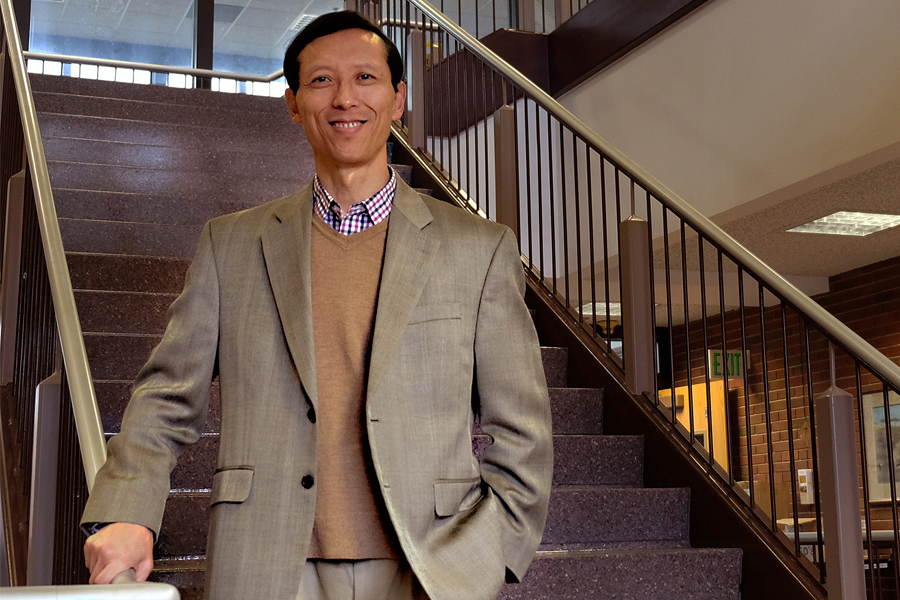World War II weapon used in new battle: Combating Parkinson's disease
A World War II chemical weapon antidote is shown to be effective combating a new enemy: Parkinson’s disease.
Parkinson’s is characterized by the steady and progressive loss of brain cells. Those afflicted show early symptoms of trembling in their hands, arms, legs, jaw and face. It can progress to the point where walking, talking or completing the most basic tasks becomes a daily challenge.
Half a million people in the U.S. are currently living with Parkinson’s disease, and another 50,000 people are diagnosed with this neurodegenerative disorder every year, according to the National Institutes of Health.
Recent studies in the Purdue laboratory of Riyi Shi (pronounced Ree Shee) reveal a new possible treatment for Parkinson’s disease from the chemical warfare antidote. The antidote drug (dimercaprol) is proving to be effective at removing acrolein, a neurotoxin that is produced in the body after nerve cells are damaged and that is directly correlated with Parkinson’s disease. In addition, acrolein has been shown to increase pain and trigger a cascade of biochemical events postulated to intensify the severity of neurodegenerative diseases like Parkinson’s.
“Our studies show that by removing the toxin (acrolein) from the brain, we are not just reducing the symptoms of Parkinson’s disease but also significantly reversing the damage of Parkinson’s disease,” said Shi, a professor of neuroscience and biomedical engineering in Purdue University's Department of Basic Medical Sciences, College of Veterinary Medicine and Weldon School of Biomedical Engineering. “This could actually provide a new treatment for Parkinson’s patients.”
When administered systematically in the body, dimercaprol nullifies certain chemical features of acrolein, neutralizing and effectively eliminating it from the brain. With fewer side effects than other acrolein scavengers and a safe, total removal via urinary excretion, Shi is moving the potential treatment forward.
Shi’s laboratory is already using dimercaprol to remove acrolein in subject models of Parkinson’s disease with promising results. So far, these studies have revealed an increased survival rate of brain cells and a significant delay of the disease’s progress. More specifically, the subjects have improved mobility and experience less pain.

“We believe that the drug’s classification and method of administration are what make it an attractive therapy option. By systematically injecting the antidote drug directly into the abdominal cavity, it can be absorbed by the bloodstream and then travel to the brain, where the disease is most harmful and where the drug can most benefit the patient,” Shi says.
A paper was published earlier this year in the Journal of Neurochemistry demonstrating how the chemical warfare antidote drug was shown to remove the neurotoxin in cell cultures, laboratory animals, and other experiments. The paper, authored by doctoral student Ran Tian and Shi, was funded by the National Institutes of Health, the Indiana State Department of Health, and the Indiana CTSI Collaboration in Biomedical Translational Research Pilot Program. The research has since progressed as a potential treatment to Parkinson’s disease.
Shi’s work aligns with Purdue's Giant Leaps celebration, celebrating the university’s global advancements in health as part of Purdue’s 150th anniversary. This is one of the four themes of the yearlong celebration’s Ideas Festival, designed to showcase Purdue as an intellectual center solving real-world issues.
The technology is patented through the Purdue Office of Technology Commercialization, and the innovation is available for licensing.
The research dovetails with the goals of a recently formed Purdue Institute for Integrative Neuroscience, at Purdue’s Discovery Park. The institute spans 25 departments and includes around 100 faculty engaged in neuroscience-related research.
Another Purdue-affiliated company helping those with Parkinson’s is SpeechVive Inc., which helps those patients speak more loudly and communicate more effectively by playing background sounds in a person’s ear while they are talking and turns off as soon as the person stops talking. This helps a person to speak more loudly, slowly and clearly.
Future research by Shi may include work to test the drug and in clinical human studies, which is feasible because the U.S. Food and Drug Administration already approved the drug.
Source: Purdue News Room
